Sphinginae subfamily
Sphingini tribe:
 |
This large bodied moth flies in tobacco fields and vegetable gardens
(potatoes, tomatoes) and wherever host plants are found. |
 |
Manduca sexta
WO, Carolina Sphinx:
Abdomen usually has six pairs of yellow bands, broken across back. Sixth set quite small.
Fw upperside: indistinct black, brown, white markings.
Hw upperside: banded black/white, with two black zigzag median lines very close together with hardly any white between them.
Fw fringes white-spotted.
|
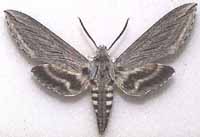 |
Not often recorded in California.
It flies in pinyon-juniper woodland and similar arid situations in
Colorado (specimen type locality) and Nevada, Utah,
Arizona and New Mexico. |
 |
Sphinx chersis
BAMONA, the Northern Ash
Sphinx or Great Ash Sphinx
The upperside of the forewing is soft dark-gray to blue-gray with
a series of black dashes, one reaching the wing tip. Note grey
thorax with narrow black lines.
|
 |
Sphinx drupiferarum
WO,
the Wild Cherry Sphinx.
Forewings, long and slender, are held close to the body when the moth
is at rest.
I only see them occasionally on P.E.I. despite visiting lights
frequently. |
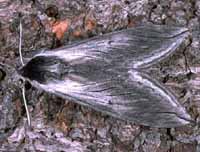 |
Sphinx perelegans
BAMONA, the Elegant Sphinx.
Sphinx perelegans adults fly in montane woodlands and mixed chaparral-type vegetation as a single brood
in the north, with adults mainly on the wing in June and July.
It flies from dusk until after midnight. Note dark thorax. |
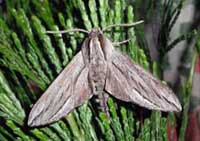 |
Adults fly as a single brood in the desert and in pinyon-juniper
woodland from May to August. generally more westerly |
 |
Sphinx vashti
BAMONA, the Snowberry Sphinx
The upperside of the forewing has a narrow black subterminal line
bordered by a white inverted V-shaped line on the outside, and a
black line running inwards from the apex of the wing.
It is most often found in montane woodlands and along streamcourses.
|
Smerinthini Tribe:
 |
This one is quite similar to Pachysphinx modesta, with modesta
being smaller and darker.
Moths should be on the wing from June-August.
|
 |
The grey-blue eyespot (without a black center pupil) of the hindwing gives this species its name.
Larvae feed on birches, willows, cherries and oaks.
The outer edge of the forewings is quite scalloped. |
 |
Paonias myops
BAMONA,
the Small-eyed Sphinx
This small species might be present. This species ranges across North
America.
The hindwings have a small blue eyespot ringed with black on a yellow
background.
|
 |
Smerinthus cerisyi
BAMONA, the Cerisyi's
Sphinx or One-eyed Sphinx, Larvae feed on poplars and willows.
Flight would be from late May-July as a single brood.
|
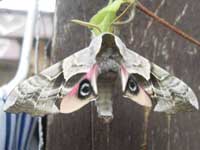 |
Smerinthus ophthalmica
WO.Larvae feed on poplars, aspen and willows.
Note different shape of double arced forewing pm line compared to the straighter pm line of cerisyi, directly above.
S. ophthalmica has smoother scalloping of the fw outer margin. Dark patch near middle of forewing inner margin
much more elongated toward body, compared to cerisyi.
|
Macroglossinae subfamily
Dilophonotini Tribe:
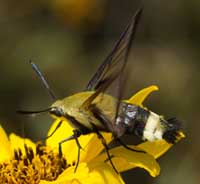 |
Hemaris thetis WO, the Thetis Clearwing or Bee Hawk Moth,
The moth flies along forest edges and in meadows, gardens and
brushy fields. Day-flying adults nectar at lantana, dwarf bush honeysuckle,
snowberry, orange hawkweed, thistles, lilac, Canada violet, etc.
|
Philampelini Tribe:
 |
Eumorpha achemon
BAMONA,
the Achemon Sphinx.
This moth should be present wherever grapes are found.
Fight would be from late May to August. Larvae feed on grape foliage. |
Macroglossini Tribe:
 |
Hyles lineata
BAMONA,
the White-lined Sphinx
Adults usually fly at dusk, during the night, at dawn, and during the
day. Moths nectar at salvia and oviposit on Epilobium cana
(California fuchsia) and Hooker's Evening Primrose. |
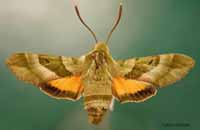 |
Adults fly in the afternoon from April-June in oak woodland and
pine-oak woodland in foothills, nectaring from chia, heartleaf
milkweed, golden currant, bluedicks, fairyfans, vetches,
thistles, hedgenettles, etc. |
|
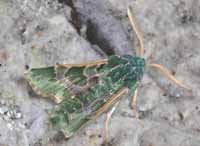 |
Proserpinus lucidus
BAMONA, the Pacific Green
Sphinx Moth or Bear SphinxThis species is confirmed in nearby Butte
County by Patience Hervey, December 29-30, 2005.
It tends to be
an early winter-early spring flier, on the wing in the early evening. It comes to lights at night. |
|
